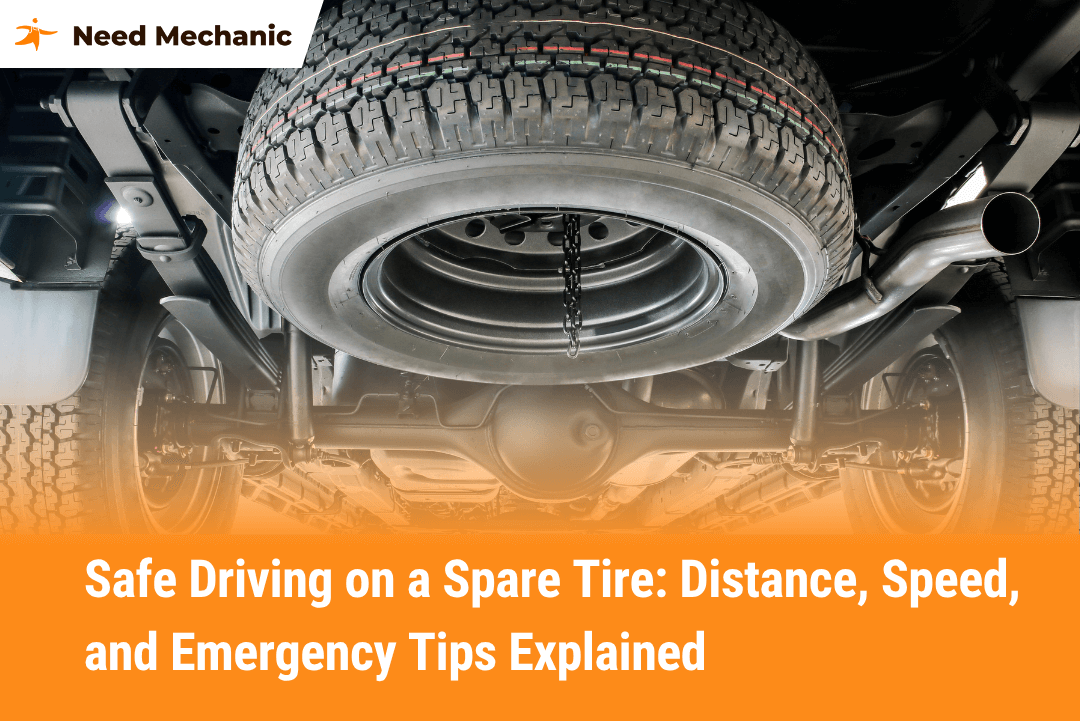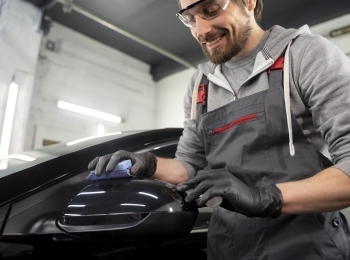A spare tire is a temporary solution that lets you drive about 50 to 70 miles at speeds under 50 mph on a donut‑style tire and up to 100 miles at 55 mph on a compact spare before you need a full replacement. In this article you will learn the exact mileage and speed limits for both donut and compact spares so you avoid unexpected blowouts and stay safe on the road. Our favorite approach, inflating a compact donut spare to the precise pressure specified in your owner’s manual, provides the best mix of reliability and performance when you’re stranded. Keep reading for practical advice on checking tire pressure, handling tricky road conditions and what steps to take once you roll into a repair shop. By the end you’ll feel confident managing any flat tire emergency from start to finish and turning a stressful situation into a smooth drive home.
Table of Contents
Why Spare Tires Important?
A spare tire is a backup tire that lets you keep driving safely when one of your main tires goes flat. It’s designed to help you reach a nearby repair shop or a safer location instead of being stranded on the roadside. Without a spare, a flat tire can leave you stuck in unsafe conditions or waiting for a tow truck for hours. Using your spare correctly helps you stay mobile, avoid extra towing costs, and prevent further damage to your vehicle.
- User benefit: Peace of mind knowing you can reach help quickly.
- Problem solved: Avoid being stranded in unsafe places or paying for unnecessary roadside assistance.
Types of Spare Tires
Not all spares are the same. Knowing which one you have is key to understanding how far and fast you can drive.
- Full‑Size Spare: Matches your regular tire in size and performance. You can drive normally.
- Temporary (“Donut”) Spare: Smaller and lighter. Designed only for short use.
- Compact Spare: A bit larger than a donut but still not full‑size. Allows slightly higher mileage and speed than a donut.

Temporary vs. Full‑Size Spare: Key Differences
| Feature | Full‑Size Spare | Temporary (Donut) Spare |
| Tire Size | Same as regular tire | Smaller |
| Tread Depth | Same as regular tire | Shallow |
| Recommended Speed | Normal highway speeds (up to 70 mph) | 50 mph or less |
| Recommended Mileage | Unlimited (until repair) | 50–70 miles |
| Ride Comfort | Normal | Firm, bouncy |
User benefit: Choose safe driving behaviors.- Problem solved: Prevent damage to your car by matching tire specs.
Safety Limits for Driving on a Spare Tire
Driving beyond your spare’s limits can damage your wheel, suspension, or braking system. Here’s what to keep in mind:
- Check Tire Pressure: Underinflated spares heat up faster and fail sooner.
- Avoid Rough Roads: Potholes and gravel roads can damage a spare more quickly.
- Watch Vehicle Handling: You may feel more vibration or pulling to one side.
Key tip: Always inflate spare to manufacturer’s recommended PSI before driving “recommended spare tire pressure”.
Recommended Speed Limits on a Spare
Speed control is vital when using a spare, especially a donut spare. Follow these guidelines:
- Donut Spare: Maximum 50 mph (80 km/h). Rapid speeds cause heat buildup and tire failure.
- Compact Spare: Up to 55 mph (90 km/h) if manufacturer allows.
- Full‑Size Spare: Follow your vehicle’s normal speed limit; check manual.
How Far Can You Drive on a Spare Tire?
A spare tire is not built for long distances. Here’s what experts say:
- Donut Spare: 50–70 miles (80–112 km). This gives you time to reach a repair shop.
- Compact Spare: 100 miles (160 km) max, if conditions allow.
- Full‑Size Spare: Drive as usual until you replace or repair the damaged tire.
Driving farther than these limits risks sudden tire failure and potential accidents.
Tips to Extend Your Spare Tire’s Life
Even within limits, you can take extra steps to make your spare last:
- Maintain Proper PSI: Check before every use.
- Rotate Your Spare: Include it in your regular tire rotation every 6,000 miles.
- Inspect for Damage: Look for cracks, dry rot, or uneven wear.
- Store in a Cool, Dry Place: Heat and moisture accelerate wear.
- Clean It Regularly: Remove dirt and debris that can weaken the rubber.
By caring for your spare, you’ll be ready when you need it most.
What to Do After Using Your Spare Tire
Once you’ve reached safety, follow these steps:
- Repair or Replace the Damaged Tire: Patch small punctures; replace large cuts or sidewall damage.
- Get Your Spare Refurbished: Some shops can refill donut spares.
- Reinstall or Rotate: If you have a full‑size spare, swap it back when others are fixed.
- Check Wheel Alignment: A flat can knock your alignment off.
These actions ensure you’re always prepared for the next flat.
Common Warning Signs to Replace Your Spare
Your spare might fail even before use. Watch for:
- Dry Rot: Cracks in the sidewall.
- Excessive Vibration: Wobbling at low speeds.
- Bulges or Blisters: Weak spots in the rubber.
- Unusual Wear Patterns: Uneven tread inside the trunk.
If you spot any of these, replace the spare immediately to avoid danger.
Conclusion: Stay Safe and Prepared
Your spare tire is a temporary fix, not a permanent solution. By understanding speed and mileage limits, maintaining proper pressure, and inspecting your spare regularly, you keep yourself and others safe on the road. Next time you hear that dreaded hiss, you’ll know exactly what to do and how long you can safely drive on your spare tire. Safe travels!
FAQs
How far can you drive on a spare tire?
The distance you can safely drive is very limited and depends on your spare tire type. If you have the small, thin donut (temporary) spare, aim for only 50 to 70 miles (80–112 km). A slightly bigger compact spare can go up to 100 miles (160 km), but that’s the absolute maximum. Remember, the spare is only a temporary fix to get you to safety. As soon as you install the spare, use NeedMechanic to post your service request or browse local shops. Finding a repair service quickly is the only way to avoid driving unsafely on the spare tire for too long.
What is the spare tire speed limit?
You must stick to a maximum speed of 50 mph (80 km/h) when using a donut spare. This speed limit is critical because the small tire cannot handle the heat generated by faster driving. If you exceed this speed, the spare tire will quickly overheat and the rubber will fail, leading to a sudden and very dangerous blow-out. Even if you have a compact spare, never go over 55 mph (90 km/h), and always check your car’s manual for its specific warning.
Can I drive 100 miles on a spare tire?
You should only attempt to drive this far if you have the larger compact spare and only if the roads are smooth and conditions are perfect. If you have the standard donut spare, do not drive 100 miles, it will almost certainly fail before you reach your destination. If your destination is far, the smartest action is to stop around 50 miles and use NeedMechanic to find a nearby repair shop quickly. This helps you get your car fixed and avoids the high risk of a sudden tire failure on the highway.
How far can you drive on a temporary spare tire?
If your car came with a full-size spare (a tire that matches the others), you can drive on it just like a regular tire until you get the flat one fixed. However, even these spares often have less tread or are an older type of tire. It’s always a good idea to get the damaged tire repaired quickly and put it back on. The NeedMechanic platform can help you schedule the repair, and you can also ask the mechanic to check the balance and alignment, which might have been thrown off by the flat tire incident.
How far can I drive on a full-size spare tire?
You can drive normally on a full-size spare tire as long as it matches your regular tires in size, tread, and pressure. It’s essentially a replacement tire, not a temporary fix. However, if it hasn’t been used for years, inspect for cracks, dry rot, or uneven tread. NeedMechanic suggests checking full-size spares during every oil change to ensure they’re road-ready when emergencies happen.
Can I drive on a spare tire for 2 days?
It’s not advised. Donut and compact spares are only designed for temporary use, ideally less than 24 hours or until you reach a repair shop. Prolonged driving causes uneven wear, strain on suspension parts, and reduced braking performance. If you need to travel longer, have the tire replaced the same day – NeedMechanic can help with emergency roadside repairs or tire replacement services.
What is the compact spare tire mileage limit?
The absolute maximum limit for a compact spare tire is 100 miles (160 km). The reason for this strict limit is due to size differences. Because the compact spare is smaller than your other three main tires, it has to spin faster to keep up. This puts uneven strain and heat on parts like your car’s differential, transmission, and brakes, which can lead to expensive damage over a long distance.
How many kilometers can I drive with a spare tire?
For the small donut spare, the safe limit is about 80 to 112 kilometers. For the slightly larger compact spare, you can push it to 160 kilometers maximum. You must treat these distances as a hard limit, not a goal. Use the time the spare gives you to find a repair solution. Driving even a few kilometers past the limit significantly increases your chance of having another, more serious tire failure.
Is a spare tire safe for long trips?
Absolutely not safe for long trips. A temporary spare is simply an emergency tool. It is not built to handle the continuous wear, high-speed travel, or heavy luggage typical of a road trip. It will wear out very quickly under those conditions. If you get a flat on a long journey, use the spare only to get to the next town or service area, then arrange to have your regular tire properly fixed before you continue driving to your final destination.
How fast can I drive on a spare tire?
Drive under 50 mph for donut spares and under 55 mph for compact ones. Their lighter build and limited grip make high-speed travel unsafe. Driving faster increases tire heat, risking blowouts or steering loss. A full-size spare can handle regular speed limits, but make sure it’s balanced and inflated to your car’s recommended PSI before highway driving.
How long can you ride with a spare tire on your car?
You can safely use a donut spare for a few hours or about 50–70 miles, depending on road and weather conditions. For compact spares, up to 100 miles is acceptable. After that, the rubber compounds and tread can start breaking down. Continuous use increases the chance of blowouts or rim bending. Always schedule a repair appointment the same day to avoid further damage.
What happens if I drive too far or fast on a spare?
There are serious risks. If you exceed the 50 mph speed limit or the 70-100 mile distance limit, the spare tire will overheat and likely blow out suddenly, which is very dangerous on the road. Also, because the spare is smaller than the other tires, your car will not handle correctly. it will feel unstable when braking, cornering, or steering, increasing your risk of an accident.
Why is checking the spare tire pressure important?
The spare tire must be inflated to the exact high pressure (PSI) listed in your car’s manual, which is often much higher than your regular tires. If the pressure is low, the tire flexes too much and generates excessive friction and heat. This will cause the spare to fail much sooner than expected. After the emergency, use NeedMechanic to find a professional shop that can confirm the spare is inflated correctly and check the pressure on your other tires, too.










Leave a Reply